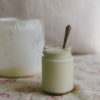24-Hour Yoghurt
24-Hour Yoghurt, or GAPS yoghurt, is, as its name suggests, fermented for 24 hours. The bacteria in the yoghurt culture consumes the milk sugars (lactose), growing in numbers until there are about 708 billion beneficial bacteria in 1 cup of yoghurt. This makes it virtually lactose-free and easier to digest. Make sure you also try 24-Hour Sour Cream and Yoghurt Cheese, they’re addictive.
Ingredients
1.5L (6 cups) unhomogenised milk (preferably organic)
100g good-quality natural yoghurt (with live cultures and preferably no milk solids),
or 1/3 tsp bacillus bulgaricus yoghurt starter
Also Needed
yoghurt maker with sterilised 2L jar (or small jars to hold 1.6L),
or various jars to hold 1.6L and dehydrator,
or 2 x 1L thermoses and towels
Instructions
Method
- Pour milk into a heavy-based saucepan and heat gently, stirring often to prevent the milk from sticking to the bottom of the pan, over medium–low heat. Use a thermometer to make sure the milk reaches 90°C. (If you don’t have a thermometer, look for small bubbles appearing at the edge of the pan.) Do not bring to the boil.
- Cool milk to between 37°C – 40°C It will cool more quickly if poured into a bowl and set aside in a cool spot.
- Add yoghurt starter to milk and stir in with a wooden spoon. (The bacteria in the yoghurt will die if you mix it in while the milk is still hot.)
- Pour into jars and set in a dehydrator or yoghurt maker for 24 hours at 37°C. Your yoghurt makers may require you to set the timer and turn on the ‘warming’ button. You will not need to set a temperature as the machine will do this automatically and adjust according to the room temperature.
- Alternatively, pour into insulated thermoses, wrap well in towels and leave in a warm place for 24 hours; or place jars in the oven with only the oven light on, to keep warm. (You may want to check the oven temperature with a thermometer first – if it’s not warm enough, get a 60-watt bulb for the oven.)
- Once the yoghurt is ready, set aside 100g yoghurt in a clean glass jar ready to use as a starter for your next batch.
Thermomix® notes
Pour milk into TM bowl and cook 25 mins/90°C/speed 4. Cool milk to between 37°C – 40°C. (It will cool more quickly if poured into a bowl and set aside in a cool spot.) Continue with recipe as above.
Notes
The yoghurt sometimes separates slightly; just stir gently, then refrigerate. If yoghurt separates in the fridge, pour off whey (the clear liquid), reserving it for other recipes. Sometimes a batch of yoghurt will be runnier than usual – it really depends on the culture and the temperature during the 24 hours setting. It will thicken slightly in the fridge.
Variations
24-Hour Sour Cream:
This is made the same way as yoghurt, except using 1L (4 cups) pure cream (no additives, preferably organic) instead of milk, and 70g natural yoghurt as the starter. If using the Thermomix to heat the cream, stir on speed 3 rather than speed 4 so you don’t end up with a thick layer of butter on top of the sour cream! The end result will be a delicious, thick, mildly sour cream, which can be served as a condiment with meals, or eaten like yoghurt with honey or fruit. Some people find they can tolerate sour cream better than yoghurt. Store in a glass jar or container in the fridge for up to 2 weeks, or freeze for up to 3 months. Frozen sour cream may separate; stir gently to reconstitute before refrigerating.
Yoghurt Cheese (Labne):
Line a strainer with a nut milk bag, or a large piece of muslin folded into two or three layers, and place over a bowl. Pour in the yoghurt, twist top of nut milk bag or muslin tightly (or tie in a knot) and place in the fridge for 12–36 hours. The longer you leave it, the thicker the cheese will be. When the cheese is the texture you prefer, pour any whey in the bowl into a glass jar and remove the cheese to an airtight container. Store whey in the fridge to use in other recipes and store cheese in the fridge for up to 1 week. Yoghurt cheese is a great substitute for cream cheese and can be mixed with herbs and garlic to make a delicious dip. Alternatively, roll the cheese into small balls, place in a jar with some fresh herbs and cover in olive oil. This will keep in the fridge for up to 1 month.
Serving suggestions
Serve yoghurt cold, mixed with honey and/or chopped fruit, with Roasted Fruit, or in Lemon Yoghurt Cake.
Storage
Store in airtight containers in the fridge for up to 2 weeks, or freeze for up to 3 months. (Frozen yoghurt may separate; stir gently to reconstitute.) If using the yoghurt to make another batch, use within 1 week.
Find it online: https://quirkycooking.com.au/2021/03/24-hour-yoghurt/
